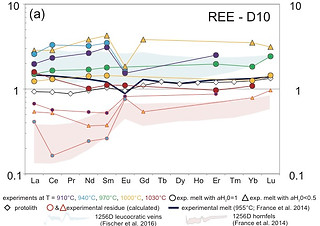Welcome to Celia Dalou's personal website
My research focuses in the understanding the behavior of volatile elements (H, C and N) during planetary formation combining experimental petrology, vibrational spectroscopy and state of the art analytical techniques.



In publication using the DOUBLE FIT program, please cite:
DOUBLE FIT: Optimization procedure applied to lattice strain model for pyroxenes
by Dalou C., Boulon J., Koga, K.T., Dalou R. and Dennen R. (2018) Computers and Geosciences,
Clic on the following logos to download the executable file for Mac.
Clic here to download the executable file for Windows (works only with 64b):
PLEASE READ THIS BEFORE USING:
Clic here to download the executable file for Linux (works only with 64b):
Clic on the following folders to download data to test the program:
To test olivine, garnet and amphibole:
To test clinopyroxene and orthopyxene:
Elements partition coefficients between Earth's phases are tools commonly employed to interpret geochemical signature of mantle-derived igneous melts and rocks. Trace element abundances in magmas can constrain their depth, temperature, and extent of partial melting in the mantle, since trace element partitioning between phases in equilibrium strongly depends on the chemical composition of melts, residual minerals and melting pressure (P) and temperature (T) conditions. Therefore, partition coefficients (Ds) cannot be used as fixed values in geochemical models. Understanding their variation with P-T conditions, mineral and melt composition is primordial.
To do so, results of trace element partitioning studies are interpreted within the framework of the lattice strain model (Blundy and Wood, 1994), which describes the substitution parameters of elements in different crystal sites. In mantle minerals as olivine or garnet, trace element cations, divalent, trivalent and tetravalent, are mainly substituted in one site, M2 octahedral and X dodecahedral site, respectively. Lattice strain model parameters for those minerals are thus fitted for one crystal site.
To apply the lattice strain model to both sites and fit experimentally determined trace elements partition coefficients, we propose a lattice train model fitted by a differential evolution constrained algorithm (Storn and Price, 1997). The optimization procedure of the model called DOUBLE FIT generates double parabolas fitting experimentally determined trace element partition coefficients using a very limited amount of data (7 experimental data point to the minimum) and offers the fastest calculation of the best-fit values for the lattice strain parameters for both pyroxene sites: r0M1, r0M2, E0M1, E0M2, D0M1 and D0M2. This new modeling procedure allows precise observations of the interdependence of M1 and M2 sites of pyroxenes and therefore facilitates the interpretation of the effect of P, T and compositional effects on trace element partitioning.

In contrast, in pyroxenes, trace element cations can be substituted in both M1 and M2 octahedral sites.

Erdmann et al. (2017)

Blundy and Wood (2003)



